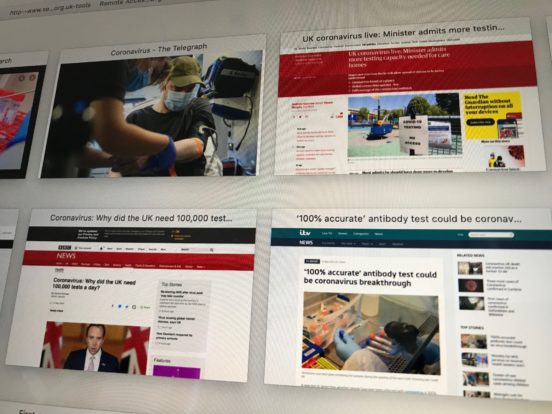“You cannot fight a fire blindfolded. And we cannot stop this pandemic if we don’t know who is infected. We have a simple message for all countries: test, test, test.”
WHO director general Dr Tedros Adhanom Ghebreyesus said at the 16th March 2020 press briefing broadcasted live on social media. He demanded governments to test every suspected case, so that they could be isolated and treated, and their contacts be quarantined. He said WHO had shipped almost 1.5 million tests to 120 countries and are working with companies to increase the availability of tests for countries most in need.
Testing for COVID-19 has been at the centre of political debate about the pandemic response, particularly in the United Kingdom and the United States. The political messaging around testing has, however, underplayed the complexity of diagnostics, says Dr Alice Street, senior lecturer at the University of Edinburgh’s School of Social and Political Science. She was speaking at the Edinburgh Infectious Diseases’ webinar series on COVID-19 on ‘The social life of COVID-19 testing’. Dr Street is the principal investigator of DiaDev, a partnership between the University of Edinburgh, Kings College London, Kings Health Partners and Public Health Foundation India, which is funded by the European Research Council.
Dr Street says the value of diagnostics has placed enormous expectations on the COVID-19 tests. They are expected to provide certainty on the pandemic situation the country. They are expected to give reassurance that the measures taken by governments and health authorities are appropriate for controlling the spread of the pandemic. They are expected to provide a guarantee for people to come out of the lockdown and get back freedom of movement. Perhaps above all they are expected to set countries back into economic production and move towards the path of financial recovery.
While demand for more testing is expected in the UK, she acknowledges that it may not be possible in many low and middle income countries (LMIC), including in countries where investments have been made in laboratory and diagnostics capacities in recent years. Drawing on experiences from DiaDev’s (Investigating the design and use of diagnostic devices in global health) research in Sierra Leone on the West Africa Ebola response in 2014-2016, and ongoing research on COVID-19 in India and the UK, she says the social value of diagnostics and the relationships between people, technology and spaces are often overlooked. Moreover, there are multiple kinds of diagnostic technologies with varying usages and benefits, but this complexity is often underplayed in political messaging potentially generating unrealistic expectations of tests.
Dr Street says different kinds of tests are best operated in different places – triaging patients, for making decisions on clinical care of individual patients and for surveillance purposes. The focus on getting the tests capacitated for the purpose of emergency responses has also diverted attention from development of laboratory capacities as a whole, particularly in LMIC, where resources are limited.
Reflecting on these experiences, Dr Street says it is evident that even in a country like the UK, there are weaknesses with the supply chain and the manufacturing system for diagnostics. The focus on point of care diagnostics may be distracting concerned authorities from considering the comprehensive system, from production to marketing, distribution, maintenance and waste management.
The values diagnostics have is different for different people and social groups. Often these values are overlooked. Investigating why diagnostics matter and what benefits are expected of them are important to their development and use, says Dr Street. Although their primary role is to inform treatment of patients, in practice this role may be least performed. Responses to Ebola outbreak and COVID-19 has shown that they have high humanitarian value and are seen to save lives. This is evident from fast tracking of regulatory procedures for its use in humanitarian responses. They have also shown to have high economic values. In the UK, increase in testing is associated with the country’s gross domestic product (GDP) and the economic recovery from the lockdown.
Testing for COVID-19 can also give the people a reassurance that the government cares. It shows that they are recognized by the state. Failure to adhere to increasing their confidence can impact their trust on the authorities. DiaDev is currently involved in a project which looks at the public perception and expectations from COVID-19 testing, to inform future testing policies. The research is carried out in Lothian, Scotland, in collaboration with the Royal Infirmary, with funding Scotland’s Chief Scientist Office.
Prof Jurgen Haas, Head of the Division of Infection Medicine at the Edinburgh Medical School says there are different kinds of tests currently available, including antibody tests which can trace past infections, but we currently do not know whether they provide information about immunity and protection. He was speaking on ‘SARS-CoV-2 in Edinburgh: Clinical situation and ongoing research’ at the Webinar.
Prof Haas is one of the six Consultant Virologists in the Royal Infirmary Edinburgh currently involved in COVID-19 response and in COVID-19 research with Scottish and international collaborators. The current testing policy in the UK is to test for COVID-19 infection only in patients and individuals living in carehomes as well as hospital and carehome staff who develop symptoms. However, previous results have shown that also completely asymptomatic individuals can be positive for COVID-19 and spread the disease. Scottish NHS Health Boards currently have a testing capacity of around 4,000 individuals per day, but in some Health Boards such as Lothian (Edinburgh) the testing capacity is not fully used since Government guidelines have not changed or not been communicated appropriately. Thus, increasing testing in elderly homes can possibly reduce death rates, he says, adding that in Edinburgh, approximately 50% of all care homes are affected.
Aphaluck Bhatiasevi is a PhD candidate in Social Anthropology at the University of Edinburgh.










Comments by abhatias